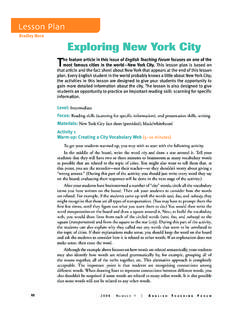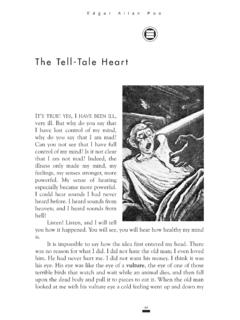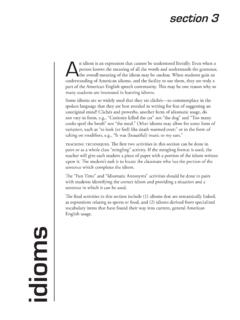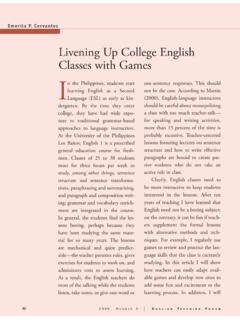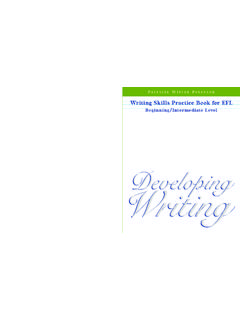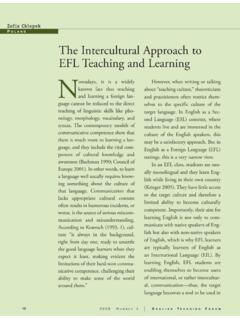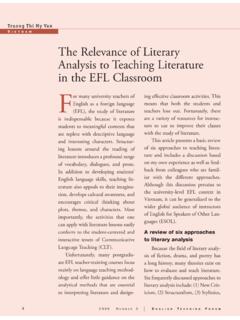Transcription of Dialogs for Everyday Use - American English
1 Short Situational Dialogsfor Students of English as a Foreign LanguageJulia M. DobsonEditorDean CurryDIALOGSFOREVERYDAYUSES hort Situational Dialogsfor Students of English as a Foreign Language~ "', """J-I I II -DIALOGSFOREVERYDAYUSES hort Situational Dialogsfor Students of English as a Foreign LanguageShort Situational Dialogsfor Students of English as a Foreign LanguageJULIAM. DOBSONDEANCURRY, EDITORANNECOVELLNEWTON, LANGUAGENOTESUNITEDSTATESDEPARTMENT OFSTATEO ffice of English Language Programsi Dialogs FOR Everyday USE Short Situational Dialogs for Students of English as a Foreign Language Julia M. Dobson Dean Curry, Editor Language Notes by Anne Covell Newton First published in 1980 Second printing 1994 by the English Language Programs Division of the United States Information Agency, Washington, DC. This printing published in 2003 by the Of fice of English Language Programs of the United States Department of State.
2 Picture Credits: Page 2 Comstock/Trucking; Page 4 Comstock/Diversity Lifestyles; Page 7 Comstock/Business Teams; Page 2 Comstock/Trucking; Page 8 Comstock/Diversity Lifestyles; Page 10 Comstock/Diversity Lifestyles; Page 12 Photodisc/Education 2; Page 13 Photodisc/ Education 2; Page 14 Comstock/Tele Connections; Page 18 Photodisc; Page 20 Photodisc; Page 22 Photodisc; Page 26 Photodisc; Page 28 Comstock/Diversity Lifestyles; Page 30 Photodisc/Education 2; Page 32 Photodisc/Business Today; Page 34 Eyewire/Wired for Busi ness; Page 40 Johanna Kowitz; Page 45 Photodisc; Page 46 Comstock/Pets Page 48 Photodisc/Business Today; Page 50 Comstock/Consumer Generation; Page 52 Photo disc; Page 53 left Photodisc/Festivities; Page 53 center EyeWire/Celebrations; Page 53 right Photodisc/Festivities; Page 54 Photodisc/Education. Office of English Language Programs Bureau of Educational and Cultural Affairs United States Department of State Washington, DC 20547 ii 510152025 CONTENTS Dialog 1 Formal Greetings and Farewells.
3 3 Dialog 2 Informal Greetings and Farewells .. 5 Dialog 3 Formal Introductions .. 6 Dialog 4 Informal Introductions .. 9 Dialog Time .. 11 Dialog 6 A Telephone Call .. 15 Dialog 7 Happiness .. 17 Dialog 8 Ordering a Meal .. 19 Dialog 9 Birthdays .. 21 Dialog A Crowded Theater .. 23 Dialog 11 Mistakes .. 24 Dialog 12 Games .. 25 Dialog 13 Health .. 27 Dialog 14 Sports .. 29 Dialog Asking Directions .. 31 Dialog 16 Coincidences .. 33 Dialog 17 Safety .. 35 Dialog 18 Musical Instruments .. 37 Dialog 19 Taking a Vacation .. 38 Dialog Recipes .. 39 Dialog 21 Weather .. 41 Dialog 22 Having Things Done .. 43 Dialog 23 Mailing Letters .. 44 Dialog 24 Animals .. 46 Dialog Shopping .. 47 Dialog 26 Transportation .. 49 Dialog 27 Comparing .. 51 Dialog 28 Pastimes .. 52 Dialog 29 Weddings .. 53 Dialog 30 Effort .. 54 iii 1 FOREWORD he 30 Dialogs included in this booklet appeared originally in the English Teaching Forum (Vol.)
4 10, May June 1972, No. 3) and are reprinted with very slight changes. Dialogs for Everyday Use are situation based, the emphasis being on realism and naturalness to the extent that these are possible within the limitations imposed by a short, self contained text. The speakers express themselves naturally in the way native American speakers might speak in certain Everyday situations. Speech is at normal speed and with standard pronunciation and intonation. The Language Notes provide information on grammar and intonation patterns, give cross references to similar patterns in other Dialogs , and suggest additional examples that can be used for drills on the structure in question. An audiocassette is available with the booklet and is a necessary component of the audio study unit. 2 DIALOG 1 Formal Greetings and Farewells Paul: Hello. How are you? Don: Fine, thank you. How are you? Paul: Fine, thanks. (bus sound effect) Oh, excuse me here s my bus. Good bye. Don: Good bye.
5 Language Notes Hello. Good morning or good afternoon might also be used. They are somewhat more formal. How are you? Notice the into nation. This how question is one of the few instances in which a form of BE receives the primary sentence stress. (This phenome non normally occurs in question word questions in which the form of BE stands at the end or is followed by a non demonstra tive pronoun: What IS it? Where IS he? When WAS it? Where will it BE? Where have you BEEN?) Sometimes, however, speakers stress the you, so that the intonation is identical to the response question described below. How are you? Notice that the responding speaker uses a differ ent intonation for this question than the first speaker used. The shift of stress onto you points to that word as carrying the new or changed bit of meaning in this question, which is otherwise iden tical to the question in the first line for now the you refers to a different person than it did in the original question.
6 (Sometimes the responding speaker will answer simply, Fine, thank you and you? omitting all the words of the understood question except the one word you, which, uttered with a strong stress, carries the new meaning. For an example, see Dialog 2.) Thanks is slightly less formal than thank you. Notice the contrac tion here s (= here is). 3 4 DIALOG 2 Informal Greetings and Farewells Dick: Hi! How are you? Helen: Fine, thanks and you? Dick: Just fine. Where are you going? Helen: To the library. Dick: I ll see you later. So long Helen: So long. Language Notes Hi is an informal equivalent of hello. For the intonation of How are you? see Dialog 1. Fine, thanks and you? See Dialog 1. Notice the rising intona tion on and you? Notice that the normal response to Where are you going? is simply To the library not I m going to the library. It is unnat ural and unusual to repeat the information already supplied by the question. is a less formal equivalent of all right.
7 The common saying I ll see you later is often shortened to See you later (with the I ll understood). So long is an informal equivalent of good bye. 5 DIALOG 3 Formal Introductions Margaret: Mr. Wilson, I d like you to meet Dr. Edward Smith. Mr. Wilson: How do you do, Dr. Smith. Dr. Smith: How do you do. Margaret: Dr. Smith is an economist. He s just finished writing a book on international trade. Mr. Wilson: Oh? That s my field, too. I work for the United Nations. Dr. Smith: In the Development Program, by any chance? Mr. Wilson: Yes. How did you guess? Dr. Smith: I ve read your articles on technical assistance. They re excellent. Language Notes Notice the rising intonation on the words Mr. Wilson. A falling intonation on a name used in direct address is unusual in Ameri can English and tends to sound brusque and impolite.
8 Listen for the d in I d. It is important to include the d in this expression in order to differentiate it from I like, which has a different meaning. (I d like = I would like = I want.) How do you do has the form of a question (and is sometimes fol lowed by a question mark), but it is not a question in meaning. It is simply a polite formula used in formal introductions. The response to How do you do is simply the same phrase uttered with the same intonation by the other speaker. In fact, lines 2 and 3 are not strictly statement and response but rather statements uttered by the two speakers independently and, possibly, simultaneously. He s just finished A useful pattern indicating an action recently completed. (Just is frequently used with the present per fect tense.) You may find it helpful to conduct a drill on this pat tern in conjunction with the teaching of the present perfect, using variations of this sentence, such as I ve just finished , I ve just finished , She s just finished , 6 They ve just finished , The same pattern, with start or begin, is commonly used for an action recently initiated: He s just started , I ve just started , She s just started , etc.
9 A somewhat simpler form of this pattern (just + present perfect), to indicate an action recently completed, is of even broader usefulness: He s just , I ve just , We ve just , I ve just , They ve just , etc. Development program. Since these two words constitute a com pound noun, the principal stress falls on the first word. I ve Listen for the /v/ in I ve. It is important to include the /v/ in this expression in order to differentiate it from I read, which has a different meaning. By any chance? = possibly. Used in questions to confirm some thing you think might be true actually is. 7 8 DIALOG 4 Informal Introductions (Sound of background conversation) Jim: Who s the tall girl next to Barbara? Charles: That s Mary Anderson. Didn t you meet her at Steve s party? Jim: No, I wasn t at Steve s party. Charles: Oh! Then let me introduce you to her now. Mary, this is my cousin Jim. Mary: Hi, Jim. I m glad to meet you. Jim: I m glad to meet you. Can t we sit down somewhere and talk?
10 Mary: Sure, let s sit over there. Language Notes Who s is the contracted form of who is. It should not be con fused with the possessive whose, which, although pronounced the same (/huwz/), has a different meaning. Didn t you meet Notice the use of the negative question. While generally used to indicate the expectation of an affirmative answer, here it expresses surprise that the answer to the question will probably and unexpectedly be negative. Notice that in this sentence, the strongest stress, and the high point of the intonation, falls on at although prepositions normal ly receive weak stress. It is as if at, in this case, were equivalent to present or there, as in I wasn t present or I wasn t there in which the adjective and adverb, respectively, would normally receive the strongest sentence stress. Mary, this is my cousin Jim. Notice that the introducer mentions the girl s name first, and introduces the young man to her (not vice versa). This is the normal, courteous manner of introduction among speakers of American English .

